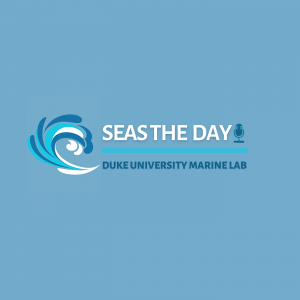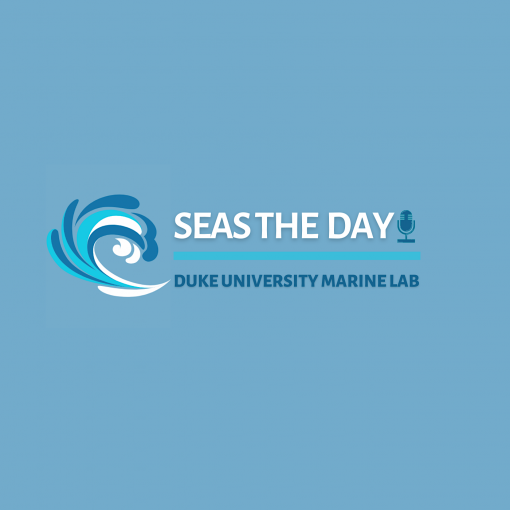What role do sea turtle hatcheries play in conservation? In this episode, Sarah Sevilla and Jessica Stevens dive into the background and various uses of hatcheries, compare the pros and cons, discuss their use in the US versus other nations, and explore improvements in and new technologies for sea turtle management. This episode features Airton Jesus, a field manager at the Turtle Foundation in Cape Verde, and Kartik Shanker, an ecologist with an interest in sea turtles, based in India. Part of our Sea Turtles series.
Listen Now
Host

Sarah Sevilla is an undergraduate at Duke University, majoring in Marine Science and Conservation and minoring in Earth and Climate Sciences. Sarah’s passion for the ocean has stemmed from her childhood as she grew up swimming and surfing. Her love for marine life and dedication to conservation has only continued to grow since her summer at the Duke Marine Lab studying sea turtles.

Jessica Stevens is an undergraduate at Duke University, majoring in Psychology, and minoring in German and environmental science and policy. Her passion for the conservation of marine life was sparked by research experiences in Costa Rica and volunteering at the Georgia Aquarium. Her recent immersion in sea turtle studies at the Duke Marine Lab furthered her commitment to the protection of the environment and wildlife.
Featured Interviews
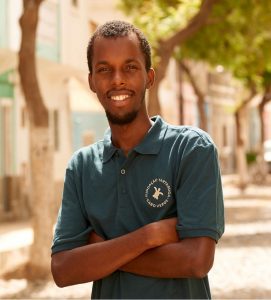
Airton Jesus is the field manager for the Turtle Foundation location in Boa Vista, Cape Verde. During his first year at university, he had the opportunity to volunteer with sea turtles. Since then, he has been studying biology and working with sea turtles across the islands of Cape Verde. In 2015, he returned to Boa Vista to continue research and take on various positions. Since 2018, he has been the field work manager.
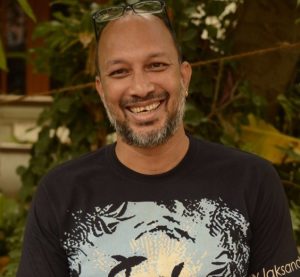
Kartik Shanker is a founder trustee of Dakshin Foundation. An ecologist by training, Kartik has interests in both mountain and marine systems. Currently, he is a Professor at the Centre for Ecological Sciences (CES), Indian Institute of Science (IISc.), Bangalore where he conducts research on a range of taxa including frogs, reptiles, birds, plants, and reef fish and other marine fauna. His work with marine turtles in the last 20 years has led to broader interests in coastal and marine conservation. His work at Dakshin is embedded in the belief that social, cultural and political contexts largely determine conservation outcomes. Kartik’s commitment to public understanding of science led him to establish Current Conservation, a magazine that bridges conservation and art by bringing together research professionals, writers and artists from different parts of the world. He is the author of the book From Soup to Superstar, a historical account of sea turtle conservation in India. In his spare time, Kartik also seeks to distract young minds through children’s stories which include Lori’s Magical Mystery, Turtle Story, The Adventures of Philautus Frog, and Moonlight in the Sea.
Hosts

Matthew Godfrey is a wildlife biologist with the NC Wildlife Resources Commission. He is also adjunct faculty at the Nicholas School of the Environment at Duke University (Marine Lab) and the Department of Clinical Sciences of the College of Veterinary Medicine at NCSU. He has worked on sea turtle biology and conservation issues for several decades.
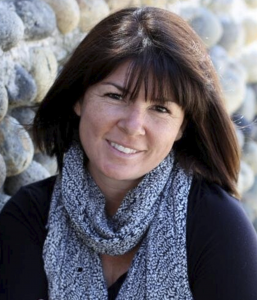
Kelly Stewart is a research scientist with the Ocean Foundation and is adjunct faculty at the Nicholas School of the Environment at Duke University (Marine Lab). Kelly collaborates widely with various groups on research related to sea turtle ecology and conservation, and is passionate about contributing to training and mentoring of students who collaborate on different research projects.
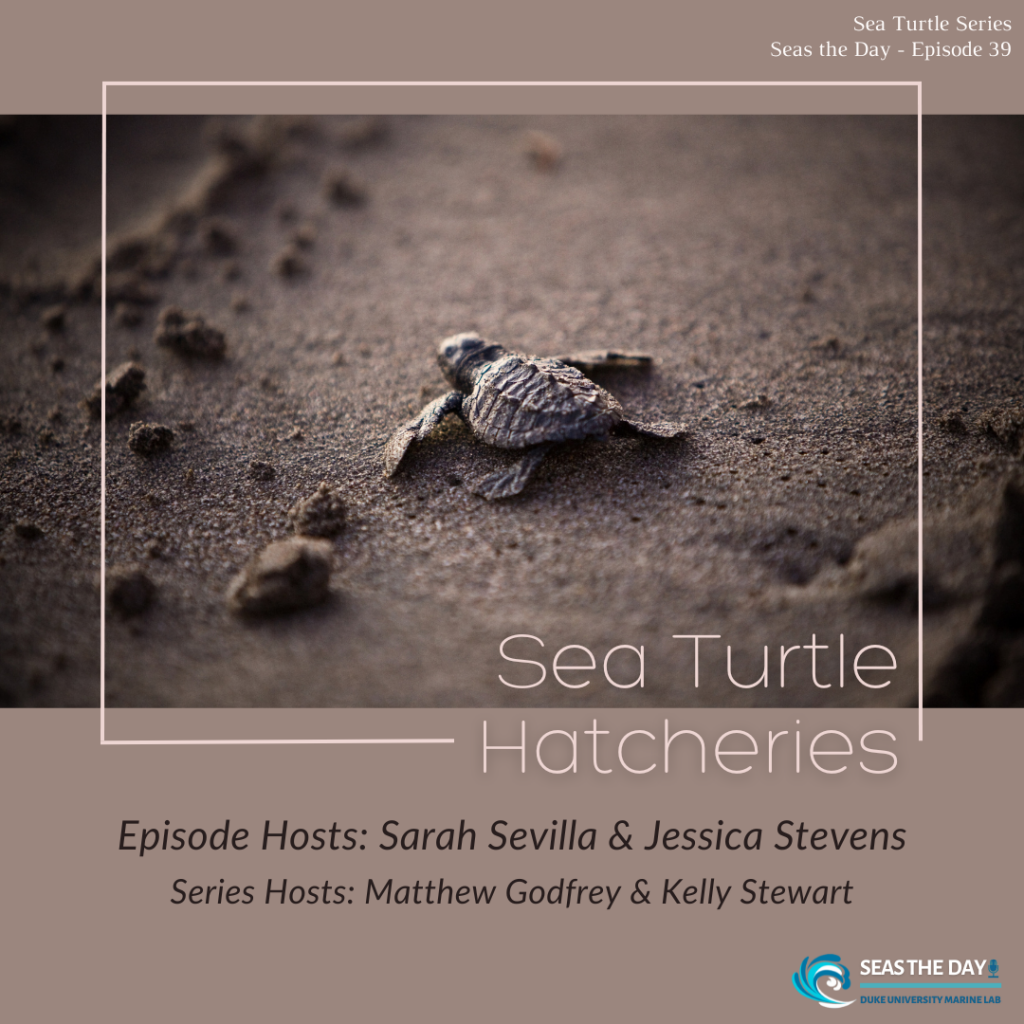
Episode 39 – Sea Turtle Hatchiers
[intro music, The Oyster Waltz]
Introduction
Matthew Godfrey: Welcome to Seas the Day, a podcast from Duke University Marine lab. I am Matthew Godfrey, adjunct Faculty at the Duke Marine lab, and I am here to introduce another podcast focused on sea turtles. In this episode, students Jessica Stevens and Sarah Sevilla examine the role of hatcheries in sea turtle conservation. I’ll hand it over to them now.
Sarah: As the sun descends below the waterline allowing for the moon to shine brightly, the air cools and the hatchlings below the surface of the sand begin to stir. After four days of working together, they emerge from eggs laid two months before and are drawn to the ocean by the bright horizon. Those that evade the wild dogs, birds, or other sea creatures, head to the deep ocean where they aren’t seen for years. Although few survive to adulthood, sea turtles at all life stages offer invaluable services to the ecosystems they occupy. As seafloor grazers, green sea turtles patrol along grassy seabeds where they eat new vegetation and replenish the sea floor with new shoots containing more nutritional value. As important predators, leatherback sea turtles chase after the tentacles of jellyfish drifting in the water column– keeping their populations in check. As inhabitants of alluring coral reefs, hawksbills act as architects, reforming the colorful underwater rainforest and building new structures by reducing coral competitors. With sea turtles occupying such a crucial role in the ocean, many different conservation efforts in different stages of their life have been employed.
Jess:In the latter half of the 20th Century, there was a growing focus on the risk of extinction to sea turtle populations in the US and other areas of the world. This led to increased focus on management techniques, like hatcheries, to help stabilize sea turtle populations. For example, in 1975 in the United States, Jekyll Island, a barrier island on the coast of Georgia, constructed their hatchery to mitigate threats to help their loggerhead sea turtle population. Across the world in Karachi, Pakistan, a hatchery was established in 1979 to protect nesting green, olive ridley, and hawksbill sea turtles. Sea turtle hatcheries were established in many places.
Sarah: Jess, can you explain what a hatchery is?
Jess: A hatchery is a protected incubation area on or near the beach where sea turtle eggs are artificially relocated soon after laying, for increased protection during their 50 plus days of incubation. The process of relocation entails digging up the natural nest and then carefully transporting the eggs to a new hole within the bounds of the hatchery. It is considered an ex situ conservation strategy vs in situ strategies that leave eggs in place where the adult female turtles laid them, although many projects will protect in-situ nests with signs, stakes and rope, or even cages to keep predators or people from damaging them. For ex-situ nests, the eggs are entirely relocated from their original location. In some cases, nests are moved to a nearby designated area of the beach. In others, however, they are transported completely off the beach to an incubation facility where they incubate until hatchlings emerge from eggs after which they are released. In some cases, hatchlings might be kept for months or years before release, to allow them to reach larger sizes that are thought to be more protected from predators. This action is referred to as headstarting, and is worthy of a separate podcast, so we won’t address it here.
Sarah: How does one go about setting up a hatchery and how does it operate?
Jess: Hatcheries can be a permanent structure with concrete footings or they can be temporary structures that are constructed at the beginning of the nesting season and then removed at the end. The specific details vary across locations and are designed to address local needs. Hatcheries heavily rely on employees and volunteers to maintain and operate them. In the words of Andrea Phillott, a sea turtle conservationist known for her work in Australia, Bangladesh, and India, the staff’s main role is in “monitoring beaches, collecting and reburying eggs, releasing hatchlings, and maintaining eggs incubation enclosures.”
Jess: Sarah, What are some of the threats to hatchlings that hatcheries are designed to minimize or eliminate?
Sarah: Eggs and hatchlings are highly susceptible to predation, habitat loss, light pollution, and extreme weather and rainfall that results in flooded beaches. In addition, human exploitation of eggs is a major threat in some areas. Additionally, hatcheries have become a tool to educate the public and spread awareness about the importance of sea turtles in marine ecosystems, as well as serve as a source of revenue through ecotourism.
Sarah: Now that you know what hatcheries are, let’s take a closer dive into some of their reported advantages in addition to reduction of threats to naturally incubating eggs.
Jess: The stated benefits of hatcheries are the protection of incubating eggs from threats, environmental education, and research.
Sarah: Dr. Andrea Phillott, who has studied various hatcheries in Australia, Bangladesh, and India, notes that hatcheries could have important consequences for future sea turtle population resilience. Hatcheries create a protected and optimal environment that protects eggs and developing embryos. Since all the eggs are in the same area, it is easier to manage and monitor incubating eggs. Ideally, hatcheries have conditions that should increase hatchling success in comparison to in situ nests that face biological and anthropogenic threats, especially when hatcheries follow recommendations designed to optimize their success. In some places, egg collection for consumption would be 100% if the eggs were not protected in hatcheries.
Jess: We talked to Airton Jesus, the field manager for the Boa Vista Turtle Foundation that works on sea turtle conservation in Cabo Verde, in the Northeast Atlantic. He provided some insight on his experience with predators and other threats to hatchlings:
Airton: Predation on Boa Vista is very high because we have a lot of crabs, Ocybode cursor is the scientific name of the crabs, it predates most of the nest. But at the same time, we try to not relocate the nests on every beach because we try to follow the nature so when you work, you relocate lot of nests, you are already changed the I will say the genes and the genetics for the, for the sea turtle. The success on the hatchery is very, very high, more than on the beach. For example, on the beach, we have some beach, we have sometimes seventy to eighty percent of the nests are predated by the crabs so it depends. And also we have some beaches on the north, we have this crabs predation, and then you have another problems. For example, you have a lot of plastic, a lot of fishing gear on this zone is a beast. You have a lot of trash on the beach. So it’s very complicated for the sea turtles when they are digging the nest and if they can dig the nest, then when the hatchlings is trying to reach the sea, they have these problems: they get stuck on the fishing gear or inside the bottles. We have a lot of problems sometimes in the beach that are on the north of the island.
Sarah: To the east, India’s coastline and beaches share similar experiences with predation of nests and hatchlings. Ecologist Kartik Shanker, who works in conservation with marine coastal systems describes the problems facing beach nesting sites:
Kartik: The success rates in hatcheries in fact tend to be lower than you would find in the wild typically, you know, wild nests you get eighty to ninety percent hatch rates and most hatcheries in India, I would say would be, sixty to seventy percent would be the mean. But here’s the thing, at least from the time that I started doing turtle work in India, which is the late eighties, the population along the coast is so large that the attendant feral dog population is so huge that I think less than ten percent of natural nests are actually left on the beach. So predation by feral dogs would be close to eighty to ninety percent. The productivity of the beach and for the hatchlings is just really low. I mean this is well after the wildlife laws were implemented and so the local take stopped, declined and sort of disappeared along the coast so there’s no more human sort of consumption of eggs, I mean very small pockets, but I’m guessing along most of the coast, most of the eggs are taken by dogs that aren’t actually protected either in situ or in the hatchery. We’ve talked through solutions for the feral dog problem and there isn’t any, there isn’t a simple one in the sense that it’s such a large problem across the entire country. I mean there are, there are researchers that are working on the dog problem relating to other wildlife issues. So, the dogs in the periphery of wildlife parks, feral dog populations and the attendant issues – rabies is a huge sort of public health issue. You know, turtles are actually fairly low on the priority of the problems that feral dogs cause throughout this country.
Jess: It is evident that in some cases hatcheries are necessary to protect sea turtles from threats like crabs, plastic pollution, and feral dogs.
Sarah: Additionally, hatcheries are an excellent tool to raise awareness and educate the local community about sea turtle conservation. Kartik discusses the tremendous emotional impact hatchlings have on people, especially young kids, leading to increased interest in environmental consciousness.
Kartik: In situ conservation is just sort of protecting nests where they are, but that doesn’t have the power of a place where you attract people and, you know, a hatchery has also provided a sense of identity for the group running the operation, then it’s got the whole public outreach component. Most of the NGOs that are involved in hatcheries either by themselves or in collaboration with the government institutions have a huge outreach component to it and I think that’s doing a lot for marine conservation. You can’t get up close and personal with any other wild animal like that and sea turtle hatchlings have got to be just amongst the cutest babies of any animals but they’re also cute babies that you can actually handle, right? I also think that as humans we have these senses and it’s one of those things that makes pets appealing to us, right? The physical contact makes it, there’s a part of this, some emotional center in our brain that it triggers and sea turtle hatchlings do that because you know, kids can come and pick them up and hold them in their hands and you know, all these like neurons fire in their head and they sort of become these lifelong well, not conservationists, but they become these lifelong, you know, enthusiasts at least. Supporters of ocean conservation and so on.
Jess: The Boa Vista Turtle Foundation uses this emotional connection to spread awareness through turtle watching:
Airton: We have some eco tourists company on the island that they have to get permission from the local authority to do turtle watching. And now we will have a new legislation that will have a kind of official oversight of this turtle watching and other activity in the nature. But in the hatchery every, I will say not now, but after August, September, every day in the afternoon, we do the hatchery nest excavation and exhumation, and we release some hatchings in the afternoon to the sea and on this everyone that wants to see, local people sometimes say, “Oh, I would like to see the baby hatchlings going to the sea.” And, we say, ”Oh, okay we will be releasing tomorrow at our hatchery at five o’clock; we will release some turtles and you can see it.”
Sarah: Finally, hatcheries allow researchers to document the number of eggs and hatchlings released to keep a record of these species. Airton explains how they use this research to evaluate the success of the hatchery:
Airton: We have a small hatchery that we use this hatchery just to do research. For example, we use the small hatchery in Boa Esperança Camp so we just use the hatchery to do research and when we want to compare the success on the beach and on the hatchery, and everyone we want to compare to study, we use this small hatchery. And on hotel beach, we just relocate the nest because of the tourist and of the light pollution and this is most of the reason that relocate the nest.
Jess: So what are the adverse effects of hatcheries?
Sarah: The under researched impact of human involvement and lack of quality control are two main downsides of hatcheries. Studies have shown that some hatcheries are not more successful than natural, undisturbed nests left on the beaches. According to Dr. Mortimer, better known as Madame Torti in the turtle community, this is a product of “improper techniques which can result in high or even complete mortality rates.”
Jess: For instance, improper techniques can lead to altered sex ratios. Sea turtles have temperature dependent sex determination, meaning that temperature influences the sex of the hatchlings. In sea turtles, warmer temperatures result in females, while cooler temperatures result in males. You can imagine that in hatcheries, there is the possibility that incubation temperatures differ from natural nests. High temperatures could not only lead to the feminization of populations, it could even kill the hatchlings. Hatcheries might use actions such as shading and watering to modulate incubation temperatures. However, without careful temperature monitoring in the hatchery and natural sea turtle nesting beaches, it is unknown what impacts these temperature changes may have on the sex of the hatchlings.
Sarah: Not all hatcheries are near nesting beaches, some might be in facilities far away from beaches, which poses problems for relocation time. Sea turtle eggs are less likely to be damaged by relocation if it is completed within 3 to 6 hours after the eggs were deposited by the female. If relocation time exceeds 6 hours after deposition, there is a higher risk of mortality because of damage to the extraembryonic membranes that stick to the shell soon after 6 hours after laying.
Jess: Additionally, concentrating eggs in a restricted area may interfere with incubation. For example, when transferring these eggs to a hatchery, nest depth is a concern for hatchling mortality. For instance, if the nest is too deep, there is a risk of eggs experiencing reduced oxygen and increased carbon dioxide, which can be fatal. Hatchlings may also have a difficult time or exhaust themselves emerging from deeper nests. Eggs from different nests placed close to each other in a hatchery may also reduce gas exchange efficiency in the sand. Another potential problem is increased bacterial contamination of the hatchery sand, which may reduce hatchling success.
Sarah: In addition, improper procedure in hatchling care is the release process. Some hatcheries may temporarily keep hatchlings in buckets of water after emergence for public viewing or for transport. However, this is not a good practice because swimming can deplete the hatchlings’ much needed energy to evade predators in the ocean.
Jess: Airton, from the Boa Vista Turtle Foundation, breaks down the importance of the female turtle’s nest site selection and the lack of research on sex-ratios:
Airton: The only way that the sea turtles have to make sure that they nest will hatch and to maximize the survivor of the nest is when they select the place to do the nest so when they select the place to do the nest, this is the most important thing they are doing for the hatchlings. And also, for example, imagine it, but we have a turtle that always make the nest close to the low tide– for example, by the natural selection, this nest will not survive. So you see this turtle, have the behavior to make the nest every time on the low tide that means maybe the hatchlings from the nest when they get adult they will make the nest, for example, the same. So when you put it in the hatchery, you are giving chance to survive some species that by natural selection will not survive. And also you are changing a lot. For example, now they are using hatchery, which to try to make the sex ratio balanced. Some are adding some shadows to like decrease the temperature because of, the climate change– we are having more females than males. So that is a strategy that they are using, like to produce more males, but also is something that’s now is not clear also because we have a lot of knowledge about the females, but we don’t know more about the males andwe don’t know what will be the good sex ratios for the males and the females will be like, maybe in the future with some research, we will know these questions.
Jess: Furthermore, constructing and managing a hatchery is expensive in the sense of materials as well as the human resources required to maintain each nest. Oftentimes, budget limitations pressure operations to rely on volunteers rather than hiring specialized staff. Although volunteers should go through proper training in order to handle the care of nests and their eggs, the possible lack of funding and qualified personnel may leave them undertrained.
Sarah: Kartik highlights that the operational problems are not information and protocols, but rather in the implementation of those protocols.
Kartik: There are at least a dozen protocol manuals across the world, in I don’t know how many languages. The problem is not technical, the problem is social in the sense that the people running these operations change, a lot of operations are run by government departments and government departments unlike the nonprofit sector tend not to have staff permanently posted at certain locations, you know, and typically people move around and so the people that are running the hatchery or the officers in charge of the hatchery change, and we ourselves internally have been saying, we need to send those, actually, we need to send those posters and manuals out every year. So, we send them out and we’re like, great we send them to everybody in the country, but actually three, four years later, you know, someone visits one of those hatches and comes back and says they were doing strange things and we’re like, but we told them! Right, but of course, and it’s not their fault because they haven’t been trained. It’s really about institutionalizing the training protocols, so it’s a social, institutional problem, rather than a technical access problem. We’ve gone out and done some training and, and then we’re like, we’ve patted ourselves in the back and we think “oh, okay.” You know, we gave them material, we gave them posters, we gave them booklets, we did it. But actually, I think we need, or our teams need, to be doing that literally every year or every six months for ten years before it then just becomes ingrained. And in places where a good protocol was established, then that inertia continues. Right so then you go back years later and you find people still following those good protocols. So, this is, sort of, dabbling more in how do you bring about social change.
Sarah: Why are hatcheries found around the world but less often in the US?
Jess: As we mentioned before, hatcheries used to be more commonly used in the US, but they have been phased out over the past several decades, largely due to these negative impacts. In recent years, hatcheries have been used only in Cape Romain National Wildlife Refuge in South Carolina and Padre Island National Seashore in Texas. In both cases, extreme conditions of the nesting beaches are thought to warrant the use of hatcheries. For instance, in Cape Romain, the nesting beaches experienced severe erosion and predators, and hatcheries were needed to allow some eggs to produce hatchlings. Sarah Dawsey, the manager of the Cape Romain National Wildlife Refuge, commented that hatcheries were phased out in 2016 because extensive trapping of wild predators, especially racoons, eliminated the predation threat to eggs and emerging hatchlings. In south Texas, nests laid by the Kemp’s ridley sea turtle are threatened by extensive beach driving, and these eggs are moved to a centralized egg incubation facility, to ensure they can safely develop and produce hatchlings without the threat of being run over by off-road vehicles.
These two examples are exceptions to the general rule that sea turtle nests laid along the east coast of the US are able to be protected where they have been laid, thereby eliminating the need for hatcheries to protect them. Public awareness and research on sea turtles have been adapted so that they can occur without the need for hatcheries.
Sarah: However, the threats that face hatchlings and sea turtles in the United States are not the same as the threats around the world. In some countries, illegal take of both eggs and nesting female turtles is common and one of their biggest concerns. In these places, it is necessary to maintain sea turtle hatcheries in hopes of protecting vulnerable populations. In some coastal communities, sea turtle meat and their eggs have a deep cultural relevance as a main source of sustenance and a reliable source of protein. For example, in Cabo Verde, the Boa Vista Turtle Foundation works with the local fishermen and farmers to provide the community with other reliable food sources.
Airton: Before we don’t have the legislation to protect the sea turtle, it was something normal to eat turtle here in Boa Vista. So in this community it was something very traditional here. So, because it’s very hard when you say “People, stop eating turtles”. We cannot just say that you must stop eating turtle simply because we have this law; instead we are always doing environmental education and community development, because sea turtles were a source of food for them so we have to give them another options. So, in this village, we work with the fishermen and we work with the farmers.
Jess: While many countries may use hatcheries, it is not a universal management technique. For instance, places like Turkey, Suriname, and Guadeloupe do not use hatcheries in their sea turtle conservation efforts.
Jess: There has been much controversy whether putting all our eggs in one basket is truly a solution for mitigating sea turtle populations.
Sarah: There’s great potential in other sea turtle conservation techniques, and people are working toward progress everyday.
Jess: While hatcheries can serve great educational purposes, programs can still be effective in spreading awareness without their use. For instance, since their phasing out of hatcheries in 2016, Cape Romain’s visitor center now has an educational program centered around sea turtles.
Sarah: There is no one blanket solution to the potential risks that hatcheries pose. Kartik offers these inspiring words about the future of sea turtle conservation:
Kartik: The good thing about turtles is I don’t know any coastal country in the world that doesn’t have a sea turtle conservation organization.
Jess: Thank you for listening to our episode: The Role of Hatcheries in Sea Turtle Conservation of the Seas the Day podcast. We hope you enjoyed and learned something you can share with family and friends. Special thanks to Airton and Kartik for their expertise on hatcheries. Keep an eye out for Kartik’s upcoming youtube series with an episode on hatcheries.
Sarah: This episode was written and produced by me, Sarah Sevilla and Jessica Stevens. For more about this episode visit our website at sites.nicholas.duke.edu/seastheday. Don’t forget to follow us on Twitter and Instagram @seasthedaypod. Thanks again and we’ll SEA you next time!
References
Mortimer, J. A. (1999). Reducing Threats to Eggs and Hatchlings: Hatcheries. Research and Management Techniques for the Conservation of Sea Turtles.
Phillott, A. D., Kale, N., & Unhale, A. (2021). Are Sea Turtle Hatcheries in India Following Best Practices? Herpetological Conservation and Biology.
Recovery Plan for the Northwest Atlantic Population of the Loggerhead Sea Turtle (Caretta caretta) Second Revision https://repository.library.noaa.gov/view/noaa/3720
https://www.cms.int/iosea-turtles/sites/default/files/document/Annex5_SriLanka_hatcheries.pdf
http://www.latinamericanseaturtles.com/archivos/documentos/Manual_Viveros_Impreso.pdf
https://www.responsiblevacation.com/vacations/turtle-conservation/travel-guide/sea-turtle-hatcheries
http://www.seaturtle.org/library/BrandGE_1999_Guidlinesformarineturtlenestprotect.pdf
Sound effects https://pixabay.com/sound-effects/underwater-ambience-6201/
Underwater ambiance
Sea and seagull wave
Ocean waves
Seagull
Gentle ocean waves, birdsong, and gull
Sandy beach calm waves water nature sounds

